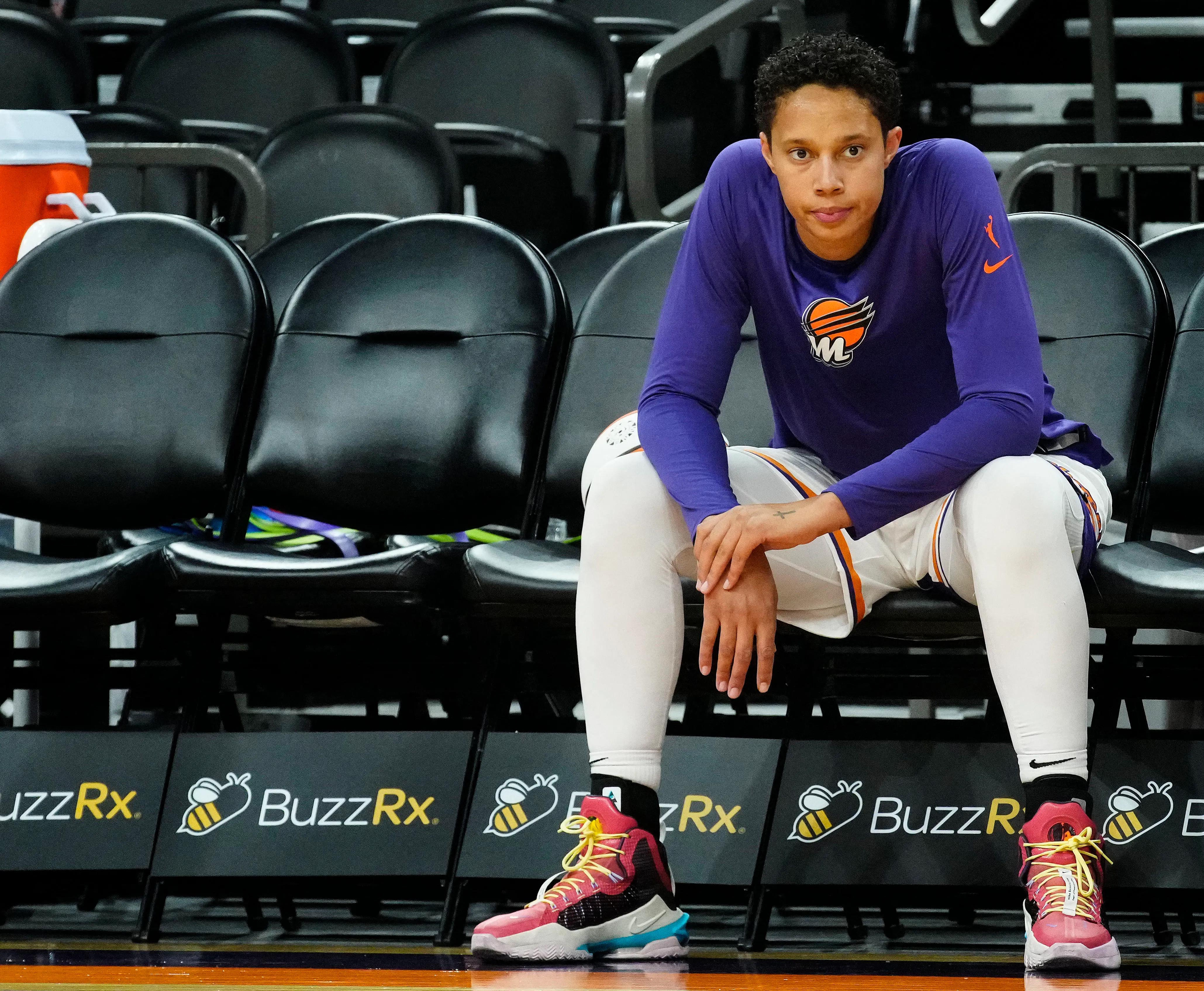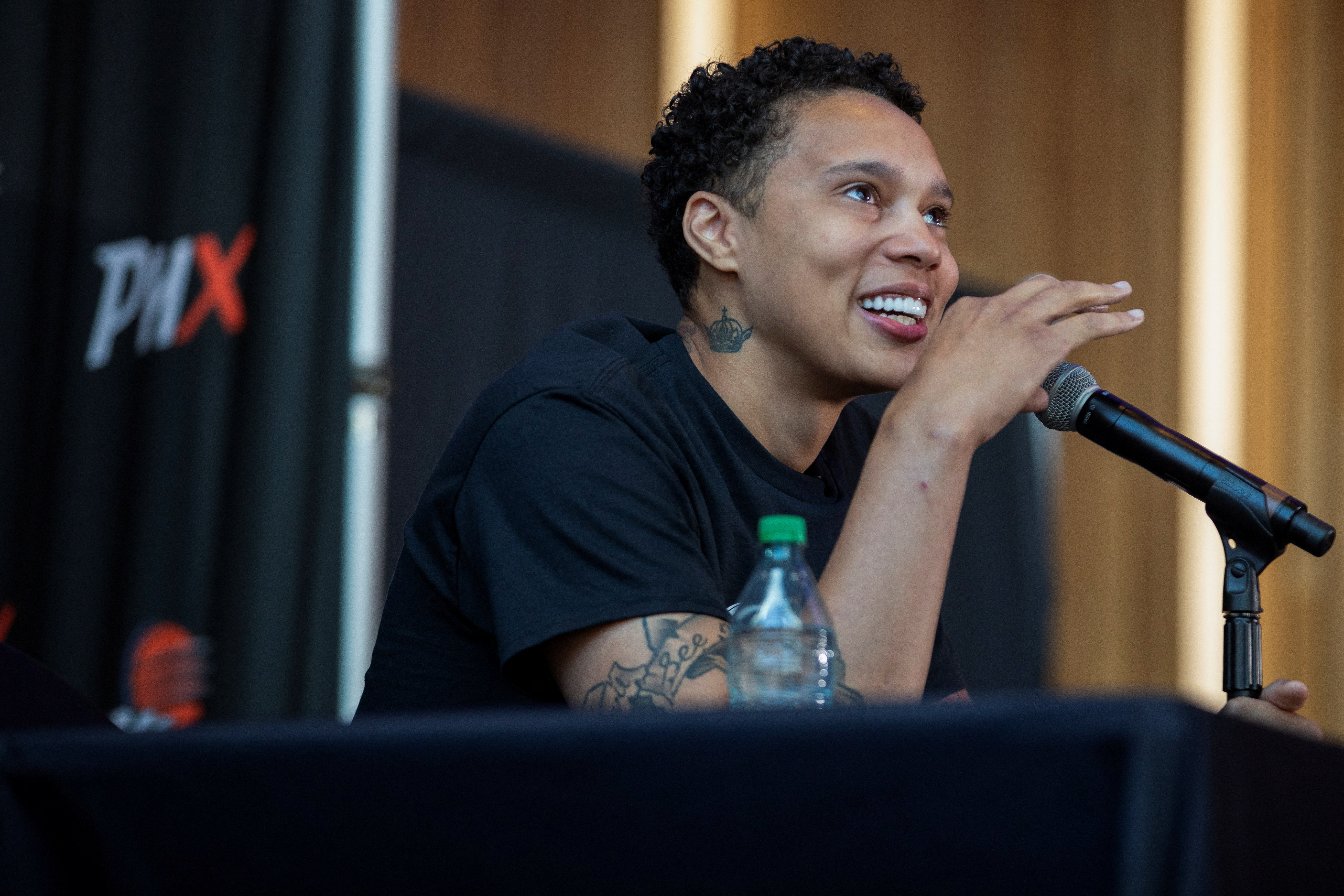
A love of basketball doesn’t keep the lights on; that’s how Brittney Griner explained what pushes so many professional women basketball players from the United States to leave the country to play the game.
The search for salaries befitting world-class athletes is also why Griner, a two-time Olympic gold medallist, travelled last year to Russia – setting off a 10-month ordeal that saw her arrested, convicted on drug charges, and jailed in a penal colony.
But for Griner, whose detention and release in a prisoner swap in December drew headlines around the world, the days of playing abroad are behind her.
“I can say for me, I’m never going overseas to play again unless I’m representing my country at the Olympics,” the Women’s National Basketball Association (WNBA) star said on April 27 in her first official news conference since returning to the US.
Still, with the new WNBA season set to begin this week – and Griner playing her first regular season game back with the Phoenix Mercury on May 19 – the US league faces continued questions about why so many of its top stars go abroad to supplement their salaries and make what experts say they are worth.
In recent years, nearly half of all WNBA players have played in leagues across Europe, as well as in Turkey, Australia and elsewhere, during the league’s off-season. Many take home salaries that dwarf what they can make in the US.
“The whole reason a lot of us go over is the pay gap. A lot of us go over there to make an income and support our families, to support ourselves,” said Griner, who was detained at the airport in Moscow in February 2022 while on her way to play for local team UMMC Ekaterinburg.
“It’s a shame that we have to leave our families for holidays. I mean, you’re missing everything being away,” she said. “But at the same time, as much as I would love to pay my light bill [with] the love of the game, I can’t, you know?”
WNBA salaries
For years, WNBA players have gone abroad to supplement their league salaries, which remain far below what they can make competing in Europe and elsewhere around the world.
The average salary among 151 WNBA athletes was $102,751 in 2022, NBC Sports reported. And this season, the minimum is set at $62,285 while the league’s top-paid players are earning the maximum of $234,936, according to Spotrac.
While the exact salaries that WNBA players can get abroad are unclear, US media outlets have reported that some of the players can earn hundreds of thousands of dollars to compete during the WNBA off-season.
Before the COVID-19 pandemic, China offered players between $50,000 and $200,000 each month for a four-month commitment, Bloomberg News reported last year, while salaries in Turkey range from about the $350,000-$400,000 mark. Meanwhile, some of the league’s top players have reportedly hauled in more than $1m, with Russia typically offering some of the most well-paid contracts.
So while Griner’s arrest and detention stopped some players from going to Russia specifically to play last year, The Associated Press reported that at least 67 WNBA athletes joined teams outside of the US despite what happened.
“The fact of the matter remains,” said Alicia Jessop, an associate professor at Pepperdine University and founder of the Ruling Sports media platform. “For many of them, there’s not just a little bit more money to be made abroad, there’s significantly more money to be made abroad.”
League structure, revenue sharing
Part of the reason why relates to the structure of the WNBA itself, which like other North American sports leagues uses the “American model”, explained Nola Agha, professor of sport management at the University of San Francisco.

Agha said while this system prioritises profits, the club team setup used in Europe and other parts of the world has allowed women’s basketball to flourish because clubs can more easily start affiliates – men’s and women’s teams across multiple sports – with built-in fanbases and brand recognition.
“That brand is fairly important,” Agha told Al Jazeera. “As a brand, you always want to win, and so you’re willing to do what it takes to win. And in sport, quite simply, that means to pay for the best players in the world.”
For that reason, she said that well before the WNBA hosted its first game in 1997 as an offshoot of the men’s National Basketball Association (NBA), female American athletes were going to play for already-established teams abroad. “The biggest stars in America made their money and they made their careers by playing in leagues outside of America,” Agha said.
Meanwhile, the gender pay gap in US professional basketball remains one of the most glaring in sport, with WNBA players getting a much smaller share of league revenues compared with their NBA counterparts.
In a 2021 report, Agha and co-author David Berri found that WNBA players were paid 21 percent of the league’s $60m in revenue in 2019. By comparison, NBA players made approximately 50 percent of their league revenue that year.
“We are not asking to get paid what the men get paid. We’re asking to get paid the same percentage of revenue shared,” Kelsey Plum, a guard with the WNBA’s Las Vegas Aces, said in an interview with The Residency Podcast in November.
“I guarantee you, as [the WNBA] continues to progress, things will change. Hopefully, my goal is by the time I leave the league, I would like to see it a lot better than I found it.”
WNBA’s efforts
Since its inception, the premier US women’s basketball league has faced challenges in attracting revenue, in part due to a lack of media attention – though that has been changing, with the WNBA setting new records in 2022 for viewership and online engagement.
The WNBA also raised $75m last year in its “first-ever capital raise” – the largest in women’s sports history. The funds – raised from more than two dozen investors including Nike, NBA and WNBA team owners, former NBA All-Star Pau Gasol and ex-US Secretary of State Condoleezza Rice – will help usher in “the league’s long-term business transformation”, the league said.
“Our strategy is to deploy this capital to continue to drive the league’s brand as a bold, progressive entertainment and media property that embodies diversity, promotes equity, advocates for social justice, and stands for the power of women,” Commissioner Cathy Engelbert said at the time.
Engelbert has personally acknowledged many of the systemic challenges facing the league, stressing that the WNBA is finding ways to help its players make more money through league-affiliated marketing and other opportunities.
The most recent collective bargaining agreement (CBA), which is in place until 2027, included a higher salary range, improved travel conditions and other benefits. It also set out revenue-sharing provisions for players to get a cut of the league’s incremental revenue, meaning they will get a share once the WNBA meets its annual revenue goal.
This season, a so-called “prioritisation” clause in the CBA will kick in, as well, allowing teams to fine and suspend players who do not show up on time for either WNBA training camp or the start of the season.
This could affect the athletes’ ability to compete abroad; WNBA training camps typically start in late April ahead of the beginning of the regular season in May, but some foreign leagues are not wrapped up by then.
“The transformation of the league is happening, and it’s working. I know a lot of people want instantaneous improvement and change – and I want that, too – but as I know, growing a business does take patience and time,” Engelbert told reporters ahead of the 2023 WNBA draft.
But Bloomberg News recently reported that while the WNBA is projected to make between $180m and $200m in combined league and team revenue this year – nearly double the $102m made in 2019 – “the players won’t see any of that extra bounty”.
“Base salaries as a share of total revenue actually shrank to around 9.3 percent” for the 2022 fiscal year, down from 11.1 percent in 2019, Bloomberg found, citing its own data analysis. And the revenue-sharing system set out in the 2020 CBA has never actually kicked in, the US news outlet said, because the WNBA has failed to reach the threshold needed to trigger the split.
Ultimately, the most recent CBA contained some “wins”, Agha told Al Jazeera but it nevertheless “didn’t bring WNBA players remotely in the equivalent position of other [female athletes] throughout the world or even NBA players”.

‘Demand for women’s sport’
According to Agha, the WNBA should be looking to do all it can to ensure that its players “could make a million dollars here at home and not have to go somewhere else” – but instead, “the structure is still in place and they’re still happy with their CBA”.
“They didn’t make any attempt to change any of that, to find a model where players stay here, be superstars, and generate the revenue that they’re clearly worth because they’re worth that much in another country,” she said.
For her part, Jessop said while the league and team owners get much of the criticism for comparatively-low player salaries, the decisions of US broadcasters also play a role. Broadcasting remains the largest source of revenue in the US sports model, she explained, which means pressure on major networks could go a long way in closing the pay gap.
“During the summer, I oftentimes can find things like pickleball, corn hole … [on television] more easily than the WNBA,” she told Al Jazeera. “And so that’s a choice. It’s a choice in programming, it’s a choice in marketing, it’s a choice in investiture.”
She stressed that this uphill battle continues despite proven interest in women’s sport: In April, the NCAA women’s championship game drew an average of 9.9 million viewers, the most in US women’s college basketball history.
“If we’re going to see greater compensation to these world-class athletes, what needs to happen is one, more broadcast of their games, which two will drive advertising revenue, and three, will drive further the valuation of that TV contract, which will put more money into their pockets,” she said.
“Broadcast partners need to realise that there is hunger, there is interest, and there is frankly demand for women’s sport to be elevated to a level that men’s sport has been elevated.”







